October 23, 1983
Thirty-eight years ago, a suicide bomber stunned America into defensive action.
I’m referring, of course, to the 1983 terrorist truck-bombing of the Marine barracks in Lebanon that killed 241 American servicemen. I was living in Washington, D.C., at the time, and I remember that within hours — as most of us were absorbing the tragic news on television, watching as rescue workers picked their way through the rubble in Beirut — federal authorities worked to prevent a repeat of that bombing in D.C.
All across town, big vehicles—usually garbage trucks—were driven up and placed in front of vulnerable doorways and driveways at the White House, the Capitol, the State Department, and any other structure that might potentially be a target for a Hezbollah terrorist or for some Hezbollah copycat.
Within a few days, those trucks were replaced by fixed obstacles, such as jersey barriers and planters. And those were ultimately replaced by permanent bollards.
Today, decades later, many federal buildings have ever-more complicated traffic-access building security systems. (In past years, I have written about the evolution of so-called passive security systems for Breitbart News here, here, and here.)
In addition, over the same four decades, just about every federal building is further protected by security guards, cameras, and weapon-detecting magnetometers.
So, we can see that when the federal government really wants to, it can take strong action to protect prized assets and people.
And when it wants to, the military can do the same for its personnel. Back in 1983, in the wake of the Beirut blast, the Department of Defense ordered a thorough inquiry led by Admiral Robert Long, a retired veteran of World War Two.
Just two months after the bombing, the five-member Long Commission issued a 141-page report, an exhaustive top-to-bottom review of all the mistakes made, such that a suicide truck laden with six tons of TNT managed to make its way 13 feet inside the building in Beirut, there to detonate.
One error, for instance, was that the Marines on guard duty were ordered to keep their weapons unloaded, in keeping with the United Nations-related nature of the peacekeeping mission.
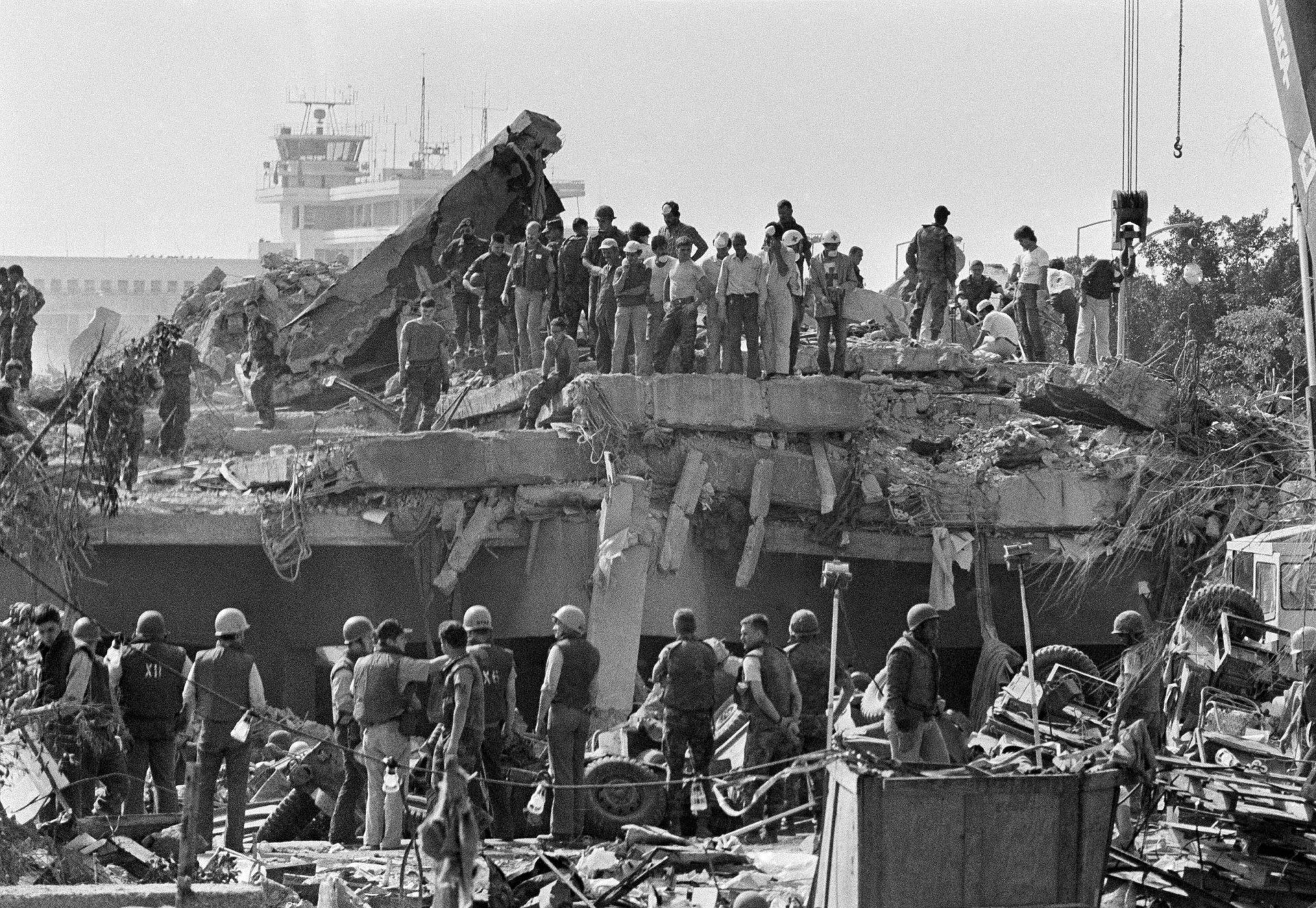
Rescuers probe the wreckage of the U.S. Marine barracks in Beirut, Lebanon, on October 24, 1983, a day after a suicide truck bomb destroyed the barracks. (AP Photo/Zouki)
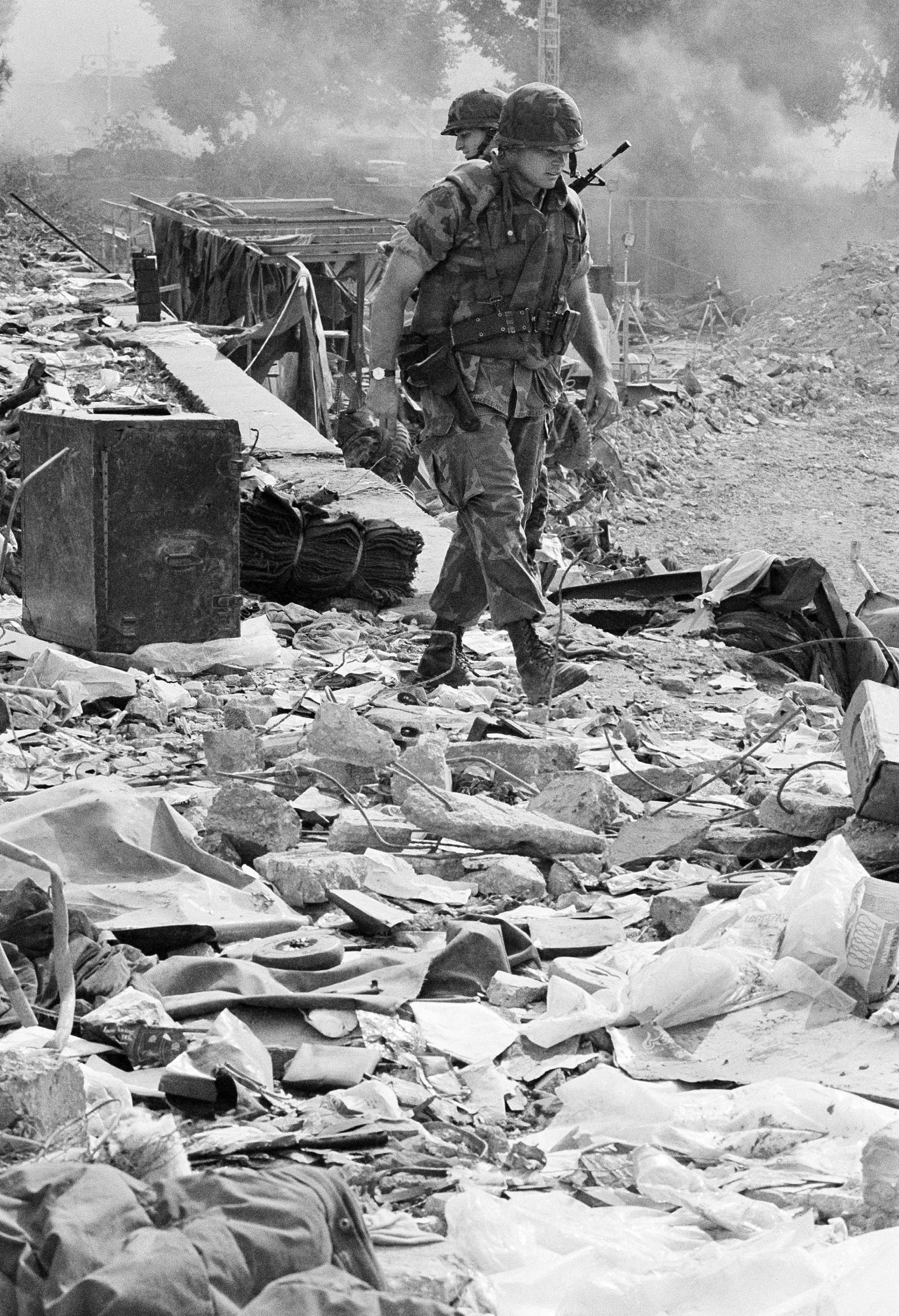
An American peacekeeper searches the debris of the U.S. Marine barracks in Beirut on October 27, 1983, looking for bodies and personal belongings of the victims of the truck bomb that destroyed the U.S. command center in Lebanon. (AP Photo/Foley)
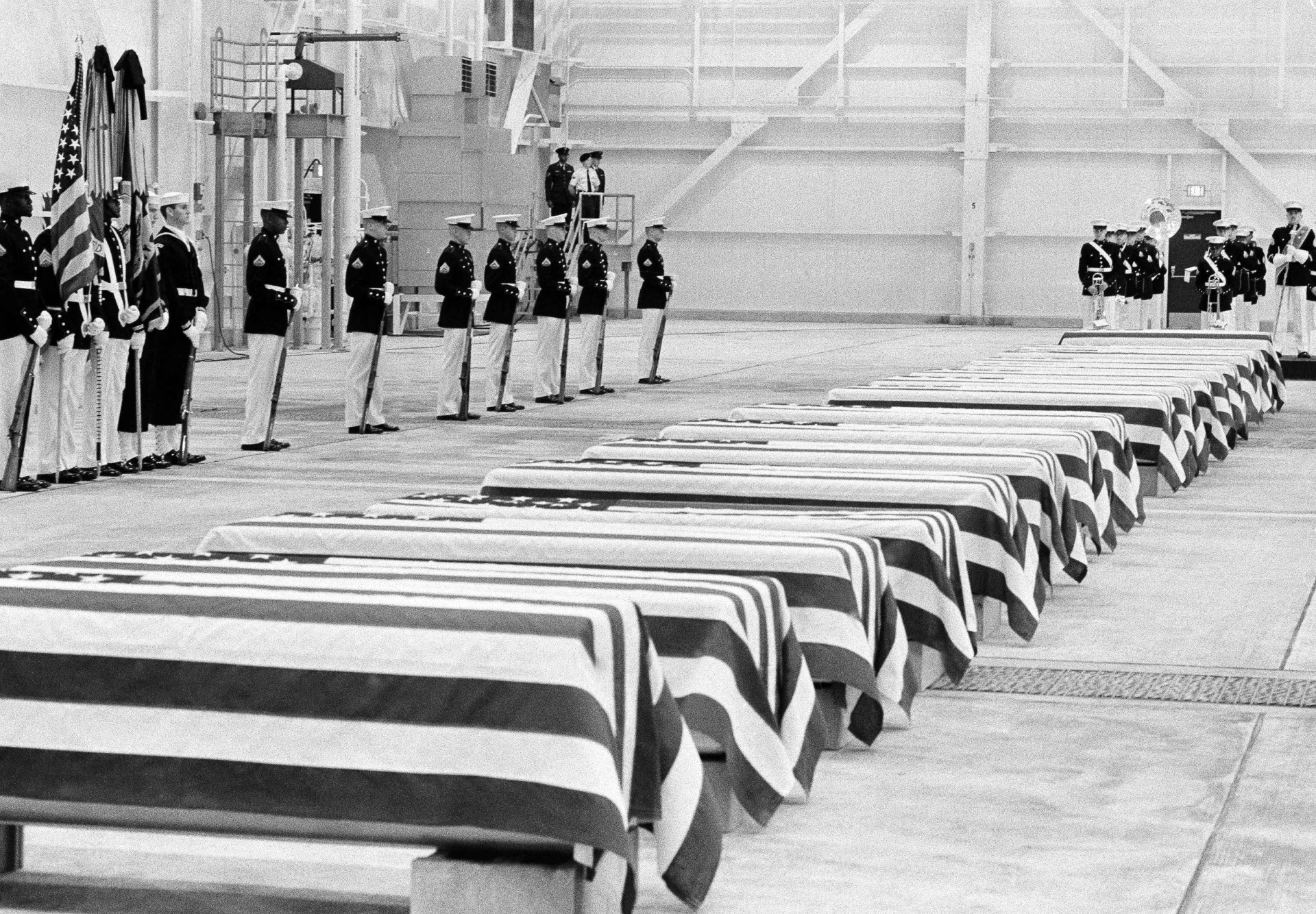
A Marine honor guard and band are shown with 16 coffins of U.S. Marines killed in the Beirut bombing, during a service at Dover Air Force Base on October 29, 1983. (AP Photo)
The Long Commission’s report was indeed thorough: “The Commission concludes that the USMNF [U.S. Multinational Force] was not trained, organized, staffed, or supported to deal effectively with the terrorist threat in Lebanon.” And the Commission further concluded, using words that would echo across the decades, “Much needs to be done to prepare U.S. military forces to defend against and counter terrorism.”
To these ends, the Commission offered 19 pages of recommendations, starting with a sharp critique of the officers in charge:
The BLT [Battalion Landing Team] commander failed to observe the basic security precaution of dispersion. The practice of dispersion is fundamental and well understood by the military at every echelon. It basically is the spreading or separating of troops, material activities, or establishments to reduce their vulnerability to enemy action. The BLT commander did not follow this accepted practice and permitted the concentration of approximately one-fourth of his command in a relatively confined location thereby presenting a lucrative target to hostile elements. The MAU [Marine Amphibious Unit] commander condoned this decision.
Yet the criticism also went higher to the dubious nature of the whole mission: “USMNF, in the eyes of the factional militias, had become . . . anti-Muslim.” Perhaps there was no way that such a perception could be avoided. And yet if so, then it was highly unlikely that Americans were going to succeed as peacekeepers in a half Muslim country in the midst of a civil war that pitted Muslims against Christians.
And so, after an inspection tour of the blast zone by a helmeted and flak-jacketed Vice President George H.W. Bush, President Ronald Reagan ordered the Marines withdrawal from Lebanon. In other words, Uncle Sam had learned a lesson about the dangers of misbegotten missions in the Middle East—at least for a little while.
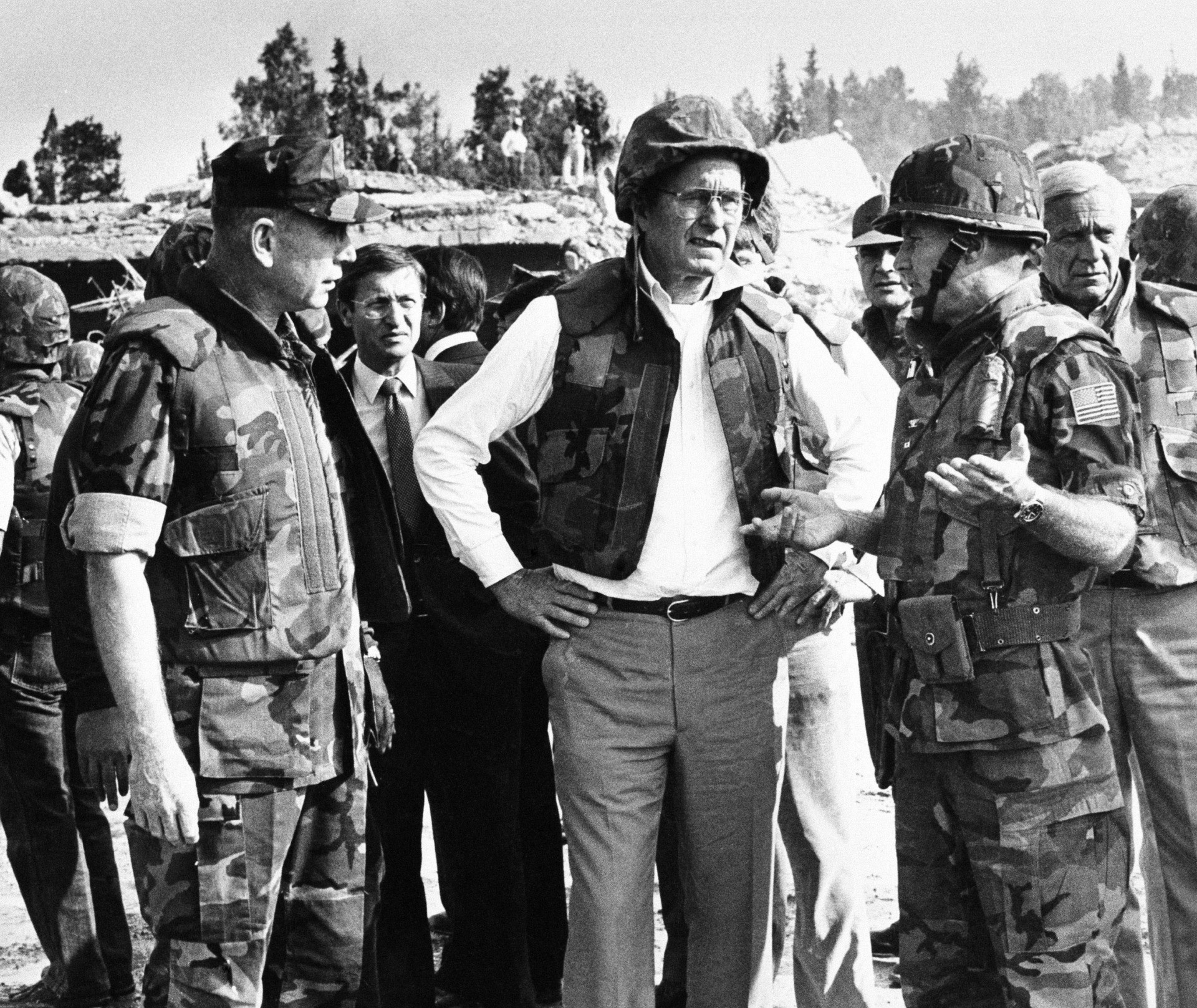
U.S. Vice President George H.W. Bush, wearing a flak jacket and steel helmet, is briefed on October 26, 1983, at the site of a suicide truck bomb attack on the U.S. Marine barracks in Beirut, Lebanon. (AP Photo)
Yet even so, the U.S. had to learn to defend itself better because no matter what we did in the Middle East, we were going to face at least some dangers from terrorists there and around the world. And the essence of terrorism—also known as asymmetric warfare—is the element of surprise. The unseen enemy is always looking to strike at an unexpected time in an unexpected way. So the defender must think imaginatively about possible threats.
And so in addition to everything else that failed in the 1983, it’s imagination that failed in Lebanon. As then-New York Times reporter, now columnist, Thomas Friedman wrote in his 1990 book, From Beirut to Jerusalem, “The Marines failed to take all the necessary precautions against something as unusual as a suicide car bomber, because such a threat was outside the boundaries of their conventional American training.”
Those are key words: conventional American training. We should say that conventional training is good and necessary, but so too is unconventional training. And equipment also must evolve, always mindful of evolving threats.
What’s Changed Since? Not Enough
Now let us fast-forward to 2021, past four decades of terrorism and thousands of suicide attacks — small, big, and horribly spectacular.
Given all those many suicide attacks, one might think that our military was well equipped to handle suicide bombers whenever and wherever they show up. After all, there’s been plenty of research on suicide bombing, as well as plenty of new tech on defending American troops in asymmetrical battle zones.
However, all that research and all that tech doesn’t seem to have trickled down to the grunts in Afghanistan. That’s why they had no choice but to pat down by hand the thousands thronging around them at the Kabul airport. The vast majority were innocent refugees, friends of America, and perhaps future good citizens. And yet one was a deadly killer–a homicide bomber. And now, 13 Americans have been killed, many more wounded, and hundreds of Afghans have been slain or maimed.
We can leave aside just for the moment the larger question as to how we got ourselves into this predicament. Hopefully, some future Long Commission—not to mention a Congressional committee or two—will consider all the missteps of the past few months, including most egregiously the abandonment of the Bagram air base, on which we spent billions to build two long runways.
For now, let’s focus only on what just happened at the Kabul airport, where U.S. troops have been holding a tiny patch of ground while screening and processing tens of thousands of refugees.
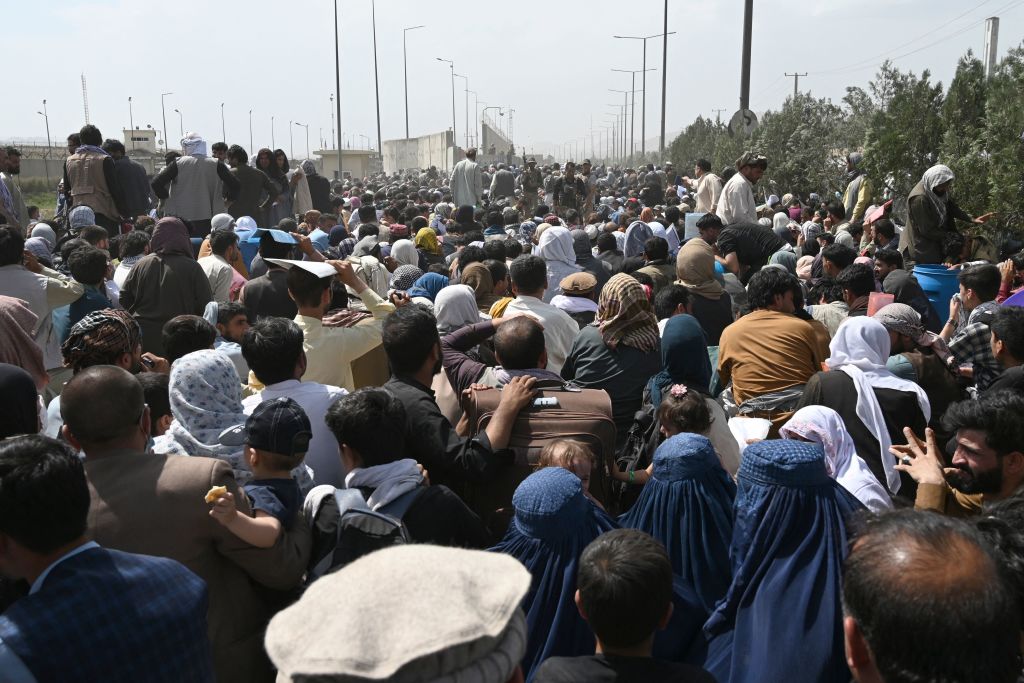
Thousands of Afghans gather on a roadside along the Kabul airport on August 20, 2021, hoping to flee from the country. (WAKIL KOHSAR/AFP via Getty Images)
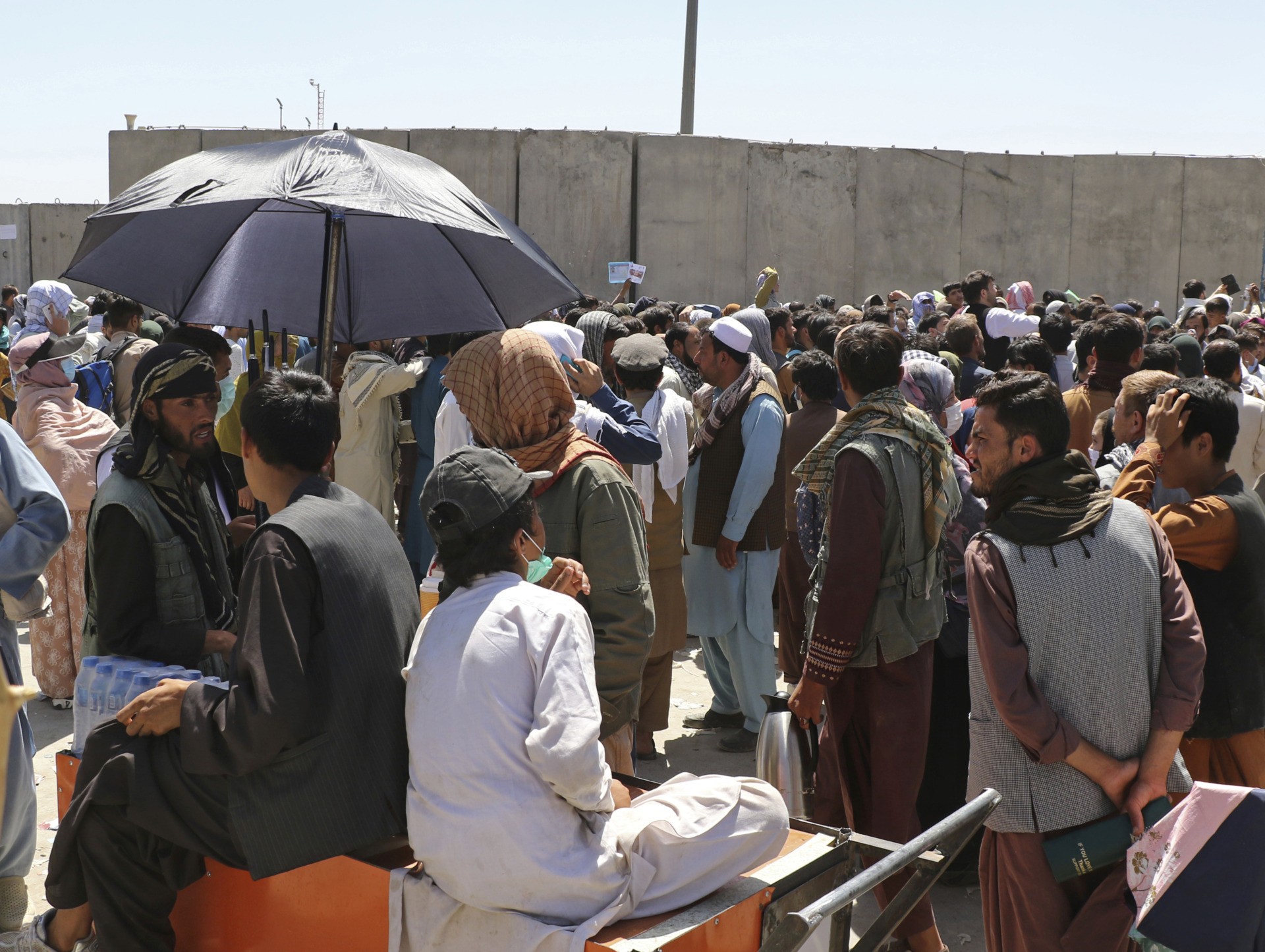
Hundreds of people near an evacuation control checkpoint at the Kabul airport on Aug. 26, 2021. (AP Photo/Wali Sabawoon)
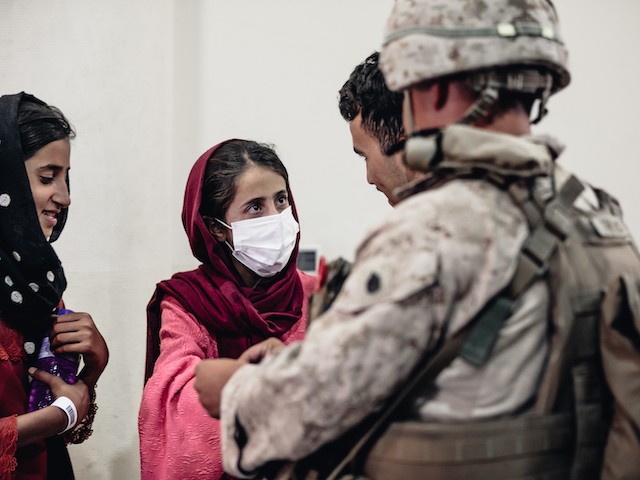
A U.S. Marine assigned processes children at the airport in Kabul, Afghanistan, on August 24, 2021. (U.S. Marine Corps photo by Gunnery Sgt. Melissa Marnell)
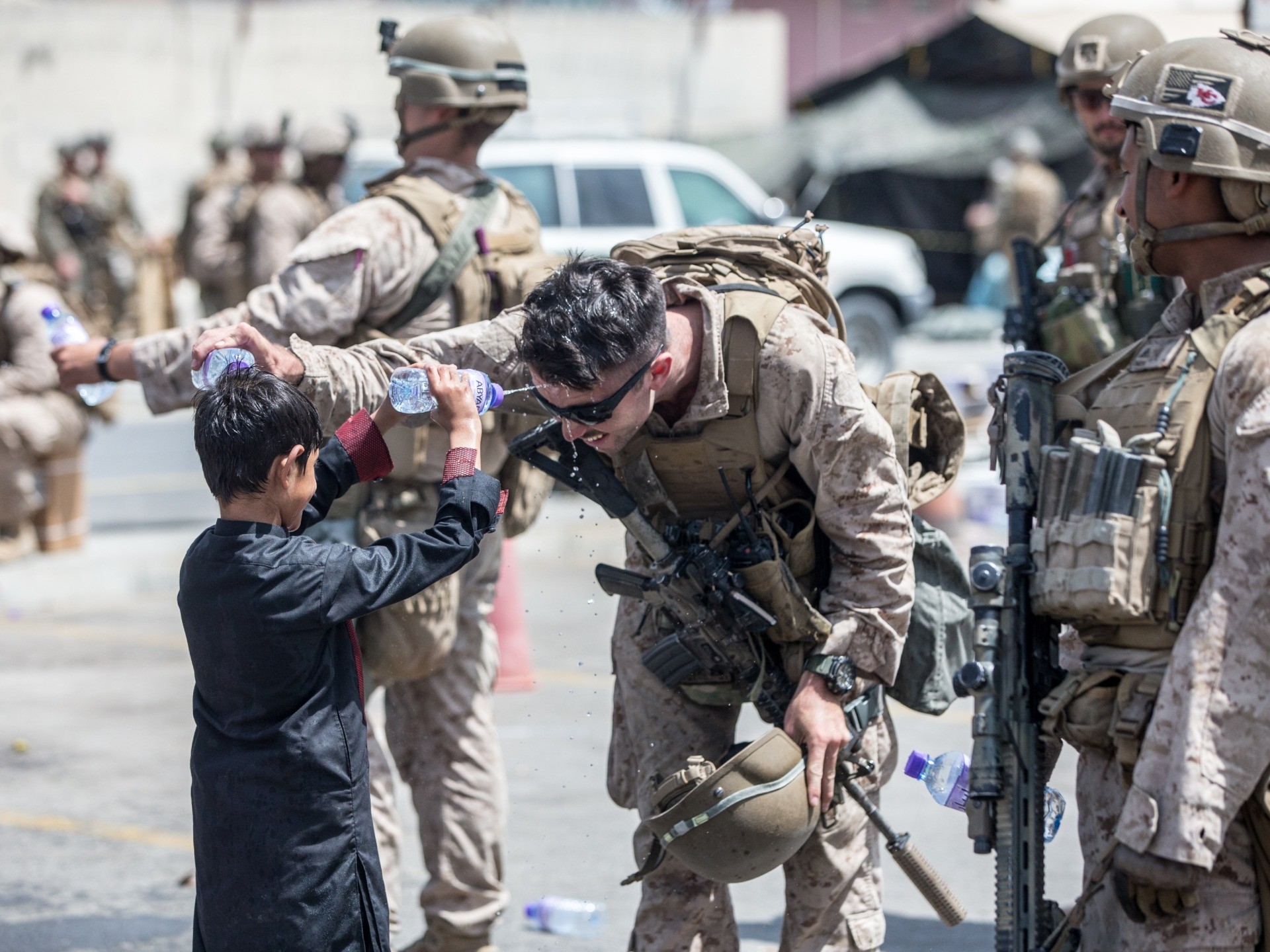
A U.S. Marine and a child spray water at each other during an evacuation at the Kabul airport on August 20, 2021, in Afghanistan.(Sgt. Samuel Ruiz/U.S. Marine Corps via Getty Images)
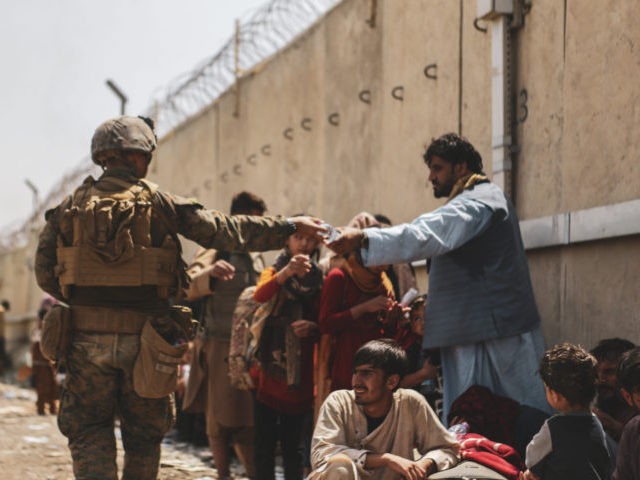
A U.S. Marine passes out water to evacuees during the evacuation at the Kabul airport on August 21, 2021, in Afghanistan. (Isaiah Campbell/U.S. Marine Corps via Getty Images)
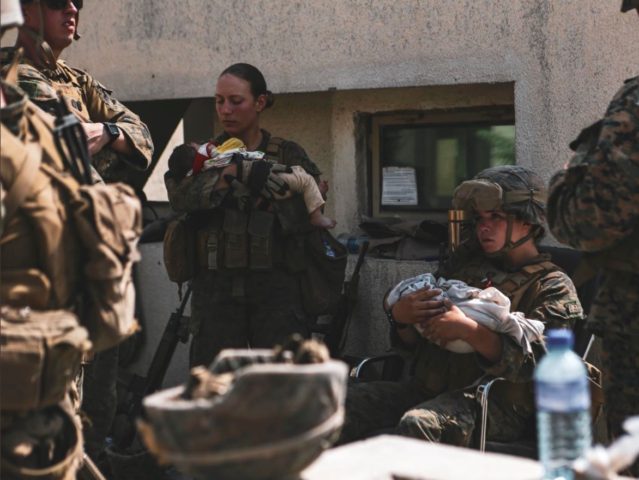
U.S. Marine Sgt. Nicole Gee (center left) seen caring for a baby days before she was killed by a terrorist attack in Kabul, Afghanistan. (@DeptofDefense/Twitter)
As we all know, the scenes there have been simultaneously harrowing and heartening. That is, it’s harrowing to see our troops in the middle of huge crowds, while Taliban gunmen—many of them armed with the best American tactical gear—look on from vantage points that are a sniper’s dream.
Yet at the same time, there, in the shadow of the valley of death, it’s heartening to see so much kindness from our troops helping children and others make their way to safety. As Rep. Seth Moulton (D-MA), himself a Marine vet of four tours in Iraq, said on August 27:
I’ve never been prouder to be an American. It’s because these young men and women are out there, willing to do it for all the rest of us and for these Afghan kids. You know, when you see a U.S. Marine grab a little girl by the hand that reminds you of your own daughter, that’s what America is all about. They represent the absolute best of America.
One of those best was Lance Corporal Rylee McCollum, 20, of Bondurant, Wyoming. As The New York Times reported on August 27, “He had been guarding a checkpoint when the explosion tore through the main gate.” Said his father, “He was a beautiful soul.” And the dad added, “It kills me and pains me that we spent 20 years there, and all the lives that were lost there, including my son’s. And we’re back to square one.”
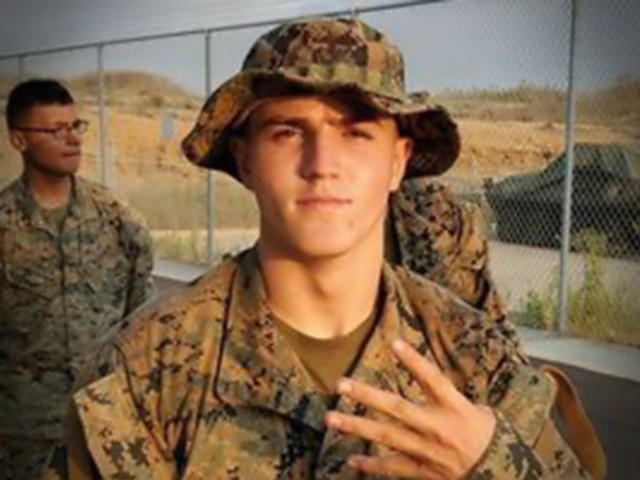
Lance Corporal Rylee McCollum (Photo via Facebook)
Yes, what happened is killingly painful.
And yet amidst the tears, we should be clear-eyed about duty. Rylee McCollum did his duty to the utmost, as did the other fallen. Now we should ensure that Rylee’s whole chain of command–up to the commander-in-chief, Joe Biden, and his predecessors–have been doing their duty. That is, the duty to do everything possible to make sure American troops have the best possible equipment for safety and security.
As we have seen, in the wake of the 1983 suicide bombing in Lebanon, the U.S. government hopped to it. Even in faraway Washington, D.C., the impact was physically transformational. And the Department of Defense also made many changes.
Yet now it’s obvious that DOD did not make enough changes. At a time when civilian employees in federal buildings were being protected by bollards and barriers, troops in the field were out there exposed, working literally with their hands. We could have done better.
Let’s let Gen. Frank McKenzie, commander of Centcom, and thus the overall big boss of military operations in Afghanistan, set the scene for the screeners:
This is close-up work. The breath of the person you are searching is upon you. While we have overwatch in place, we still have to touch the clothes of the person coming in. I think you can all appreciate the courage and dedication that is necessary to do this job, and to do it time after time.
Yes, we can all appreciate the courage and dedication of the troops on the front line.
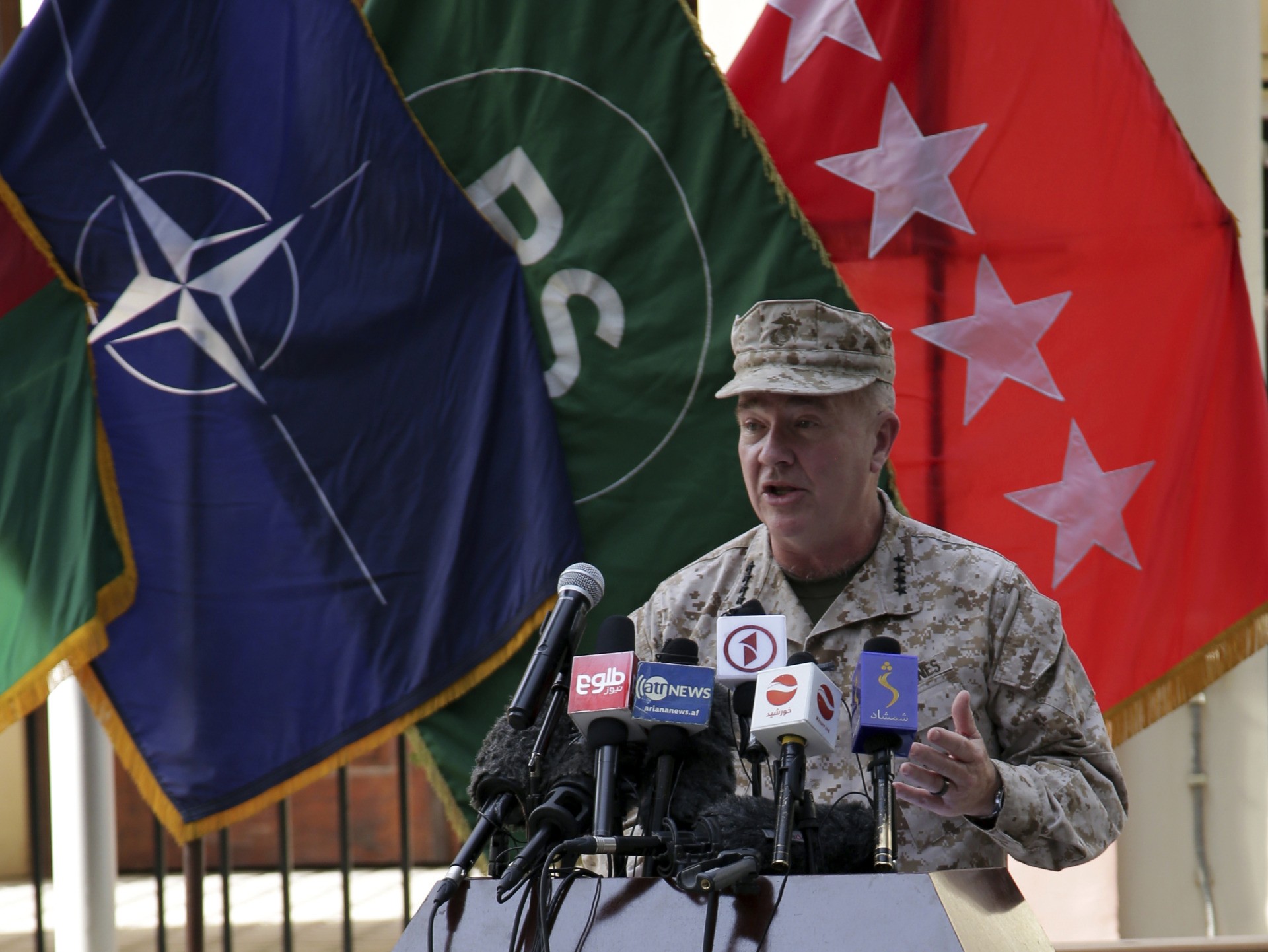
Marine Gen. Frank McKenzie, the head of U.S. Central Command, speaks at a handover of command ceremony at Resolute Support headquarters in Kabul, Afghanistan, on July 12, 2021. (AP Photo/Ahmad Seir)
Yet here’s the thing: The 20-year-olds we command to pat down and screen for suicide bombers must put their trust in 64-year-old leaders like McKenzie who are supposed to be wiser and who are expected to maintain that trust through appropriate actions. And it sure looks as though that’s where the trust broke down.
Upholding the trust of the troops in the field would have meant that those sitting behind desks would have seen to it that the troops had the benefit of the most advanced possible technology.
We can ask ourselves: Did the troops in Afghanistan have an adequate perimeter, such that the first echelon of the bomb-screen would leave Americans a sufficient distance away? Did our young men and women have bomb-detecting equipment? Did they have the latest bomb-detecting gizmo—maybe even a robot—that could have been created and deployed if there had been more energetic leadership stateside?
As we know, the military has plenty of high-tech. We just have to imagine all the ways that tech could help. And since NEOs, short for Non-Combatant Evacuation Operations, are a common enough mission that the Marine Corps has a web page devoted to it, there was plenty of time to think about better bomb-detection tech.
Or did the Pentagon chiefs think tech-less GI’s patting down thousands of people was good enough? For his part, McKenzie seems to think that low-tech is just fine: “There’s no substitute for . . . a young United States man or woman standing out there, conducting a search.”
Well, actually, there could be a substitute: better and echeloned screening technology of the sort that guards edifices in Washington, D.C., to say nothing of every airport. To be sure, in a combat zone, the mobile version of this equipment would be challenging and expensive to install, but young Americans are worth it. If they put their trust in Uncle Sam, Uncle Sam should do everything possible to keep their trust.
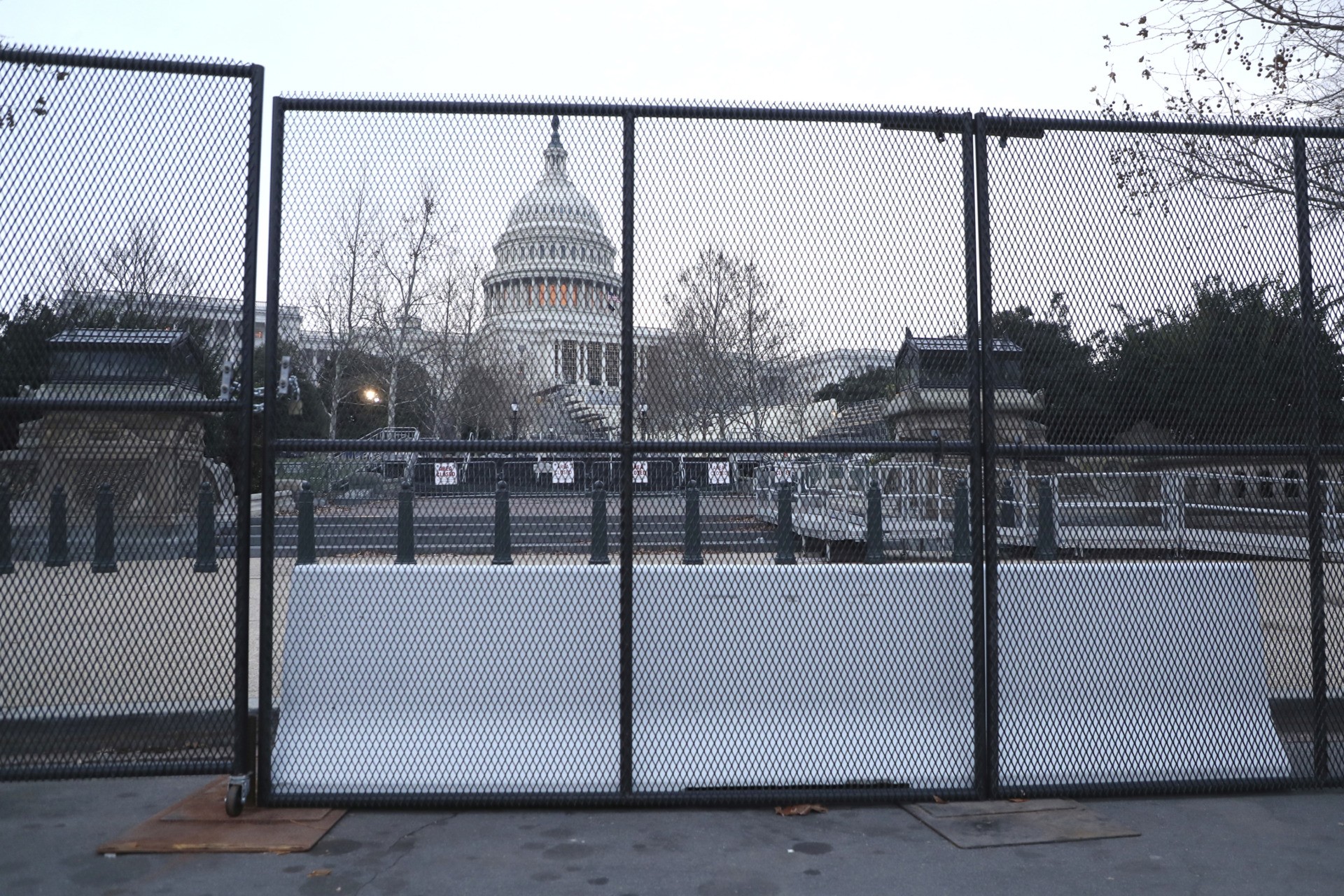
Non-scalable fencing, concrete barriers, and bollards protect the U.S. Capitol in Washington, D.C., on January 8, 2021. (AP Photo, mpi34/MediaPunch/IPX)
I might add that most every advance in the technology of war involves some sort of improved “stand off” capacity. That is, rather than fighting up-close-and-personal — where as McKenzie said, a warrior can feel “the breath of the person”— warfighters are made safer and more effective when they can project their force, be it by an arrow, a bullet, or a missile. And the same holds true for defensive security: the more that technology is pushed up front, the more that soldiers can hang back. The issue isn’t courage; the issue is common sense. Let’s wrap our young heroes in the best possible equipment; let’s mobilize the techies in Silicon Valley and elsewhere to a more important goal than building the next social-media app.
Once again, it’s a matter of imagination, and technology is all about imagination. And interestingly enough, the military had some of the imagination needed—just not enough. As Gen. McKenzie said on August 26, the day of the deadly blast, “We thought this would happen sooner or later.” And then he added, “We are prepared to continue the mission.”
Okay, we will continue the mission—as the military says, Charlie Mike. Without a doubt, the Marines and all the others in our armed forces will continue to do everything they are ordered to do, even if they lack the equipment they could and should have. So say a prayer.
After all, ill-preparation in warfare is nothing new. The poet Tennyson wrote about another misconceived mission, the charge of the Light Brigade, in 1854:
Was there a man dismayed?
Not though the soldier knew
Someone had blundered.
And the poet adds the now famous refrain:
Theirs not to make reply,
Theirs not to reason why,
Theirs but to do and die.
Yes, that’s what soldiers do. And yet at the same time, generals—and presidents, cabinet secretaries, and all the other senior officials secure in their fortified D.C. bunkers—should have the imagination and the vision to do their part too.
Because where there is no vision, soldiers perish.
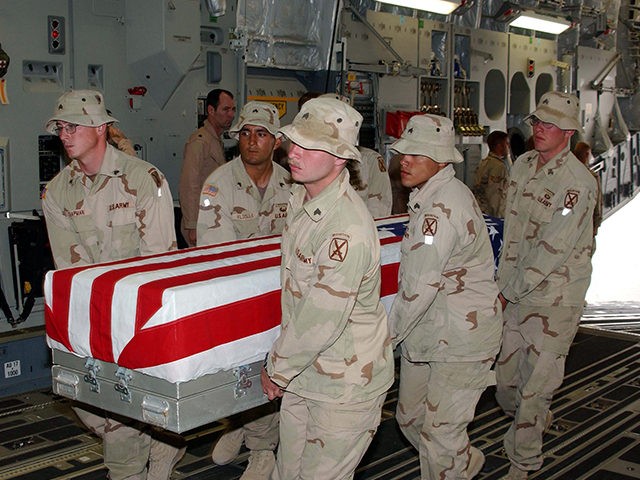
COMMENTS
Please let us know if you're having issues with commenting.